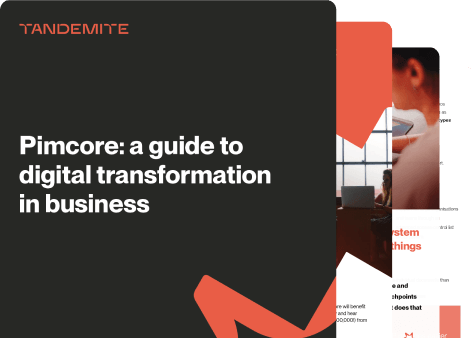PIM implementation - should your company do it? Managing product information is a tough challenge, especially for manufacturers, distributors, and retailers who use multiple sales and promotion channels. As people and data grow in numbers, unstructured activities become a nuisance and inhibit development. Managers and owners of companies are forced to look for better ways to operate. It is often at this stage that they find out about the existence of IT systems dedicated to product information management (PIM).
What do companies use before deciding on PIM implementation?
Manufacturers still primarily use Excel files for product data management. Various databases or ERP systems are also popular. Occasionally, the information is completed and stored directly in the e-commerce system. Many companies do not have a well-thought-out strategy in this area. PIM software is something completely unknown to them. They handle the new difficulties by introducing temporary, quick solutions. But to adapt a growing organization to the needs of the modern market, more advanced and better-structured actions are needed.
Companies that do not modify their strategy, while still following the old methods but adding new sales channels, they face many problems. The data they manage is usually dispersed – processed by different employees and departments. The lack of a uniform structure of product information and tools for information control causes trouble. It makes it difficult to maintain standards related to the presentation of the offer (e.g. photos with specific dimensions, complete and uniformly described parameters and consistent descriptions).
The same work may even be done many times over because it is impossible to find the files or descriptions required at a given time. This situation definitely makes development and optimal budget management difficult. Would a PIM implementation plan be a good idea? It would.
With many channels, it is difficult to maintain the essential integrity of the brand image integrity. Growing companies export product information to many sales and promotion channels. Among these, the most common ones are:
- e-commerce systems,
- mobile apps,
- B2B panels,
- stationery stores.
- price lists,
- offers,
- printed and electronic catalogues.
For international sales, language versions are added and adapted to the requirements of specific markets. It is necessary to maintain a consistent data structure in all these places.
Updates are time-consuming and long-lasting. Even if only one product parameter is changed, it can take months to update the information at every location where it is presented. Mistakes or omissions can be very expensive for the company, increasing the risk of a customer receiving a product that does not match the description, picture, or specification. Another problem is the inconsistency of price lists or offers. Some sales channels or partners may offer products withdrawn a long time ago or outdated prices.
Taking too long to market a product can result in the loss of many opportunities. Dynamic changes are a common occurrence on the market. Opportunities appear that only a few companies can take advantage of. The key factor of the success of such companies is their ability to react quickly. Ineffective management of product information and suboptimal processes constitute an impenetrable barrier at such moments. Even if a potential opportunity can be identified, it is impossible to react faster than the competition. This is when a company wants to enter a new market, launch new products quickly, or acquire a key customer.
Does it sound like your painful reality? Well, it doesn't need to be like this. If you have enough, let's talk and plan the implementation process of your new PIM software. Not convinced yet? Keep reading.
Why do companies decide to use a Product Information Management system?
Using the PIM system increases their scale of operations
The decision of PIM implementation is most often influenced by development. When the company is small, team members can easily communicate with each other. This means that they have good control over where materials are stored and with whom they are shared. However, as the organization grows, it is necessary to build and optimize processes in order to allow effective cooperation within an extensive team on a continuously increasing amount of data. Product Information Management implementation guarantees this effectiveness.
At this point, there is a need for a tool that will serve as the central storage for product information and data attributes and, at the same time, enable processing, searching, replenishment and automation of repetitive work. Safety is also becoming more and more important. Only authorized users should have access to particular resources, and only to a specified extent.
When choosing a PIM system, it is worth paying attention to its scalability so that it supports the development of the offers, number of channels, and product data structure.
Implementation and development of multichannel sales (omnichannel)
Multichannel sales are a frequent impulse for full PIM implementation in the organization. Having complete and consistent product data is key to the omnichannel strategy. The company needs to be able to effectively control whether all product information meets deliberately set standards. Without a PIM system, it can be really hard; product data will turn into chaos.
To use the potential of a particular channel, the presented materials should be adapted to its specificity. For example, the customer experience of a B2B partner feels different from an individual customer of an online store. With the PIM system, thanks to automation and central information storage, it is possible to generate appropriate data sets and update and export them to designated locations rapidly. All product data is presented exactly how you'd imagine it.
International expansion
In the context of product information, expansion into other markets is always a significant challenge, not only in terms of translating all descriptions, instructions, and materials into one or more languages. Often, there are also legal restrictions or business requirements that make it necessary to modify and supplement certificates, instructions, or specifications with those expected in a specific market.
The amount of product information and its distribution channels grows dynamically at this stage. To be able to control its quality and consistency and ensure a smooth flow, it is worth preparing in advance by implementing a PIM system throughout the organization.
Remote cooperation
The PIM system is a tool that supports remote cooperation. The restrictions of the COVID-19 outbreak have demonstrated the importance of good communication. Daily changes in working style were a necessity. In such a situation, the PIM solution becomes a tool that allows for seamless work with product information, and data modelling, even when the team is dispersed.
What motivates companies: four main benefits of PIM solution
Product data centralization
Thanks to a PIM system, extensive and diverse product data can be collected in a single location. Through the central system, authorized individuals can join the process, and expand and update information on multiple data. Everything is easy to find, and there is no confusion about which product data is up-to-date.
Process automation and improvement
The PIM solution integrates with many systems, both within the organization and with the tools used by the customers and business partners. It automates data reception, processing, and data import or export. Much of the repetitive work becomes possible to automate.
Whenever you correct an error, make changes or additions to product information through the PIM system mechanisms, the information will be instantly and automatically updated in all integrated channels.
Controlled quality of product information
The PIM system allows you to specify which data for a given product, product group or product category is required, optional, or redundant. A uniform information structure is achieved. When new products are introduced, the system will indicate which data needs to be supplemented and what the data quality criteria are.
Eliminating mistakes and reducing costs
Successful implementation of the PIM platform requires the relevant processes to be properly identified and automated. A large part of repetitive tasks previously performed manually is transferred to the system. This allows for more efficient use of resources.
PIM implementation process: where to start?
Investing in a PIM system is certainly beneficial for the development of any company that produces, sells, or promotes products. The key to success is to adjust your PIM platform to the real needs of the organization. In most cases, both the PIM implementation plan and the whole process should be handled by professionals. Like us - PIM is definitely our cup of tea (that is why we're Pimcore Gold Partner).
Today, the market has increasingly high demands regarding the consistency, quality, and completeness of information. The automation of the product data flow and its rapid updating in all channels is essential. Therefore, it is worth starting by identifying your current problems, needs, and possibilities.
Based on these insights, contact us and we will organize workshops. The workshops will provide a solid basis of requirements and assumptions for building a dedicated system, which will be able to support the company in its development. This is a good first step before taking the process of product data management to a higher level.
Does it sound overwhelming? Don't worry. You can write to us even now, without any preparation. We will start helping you right from the very start.








